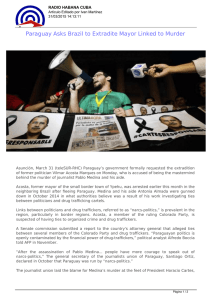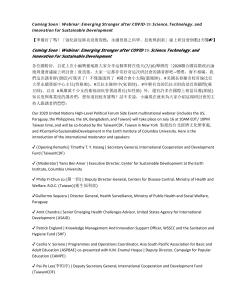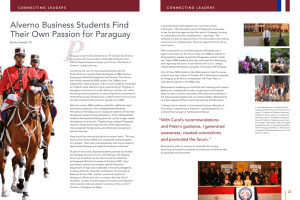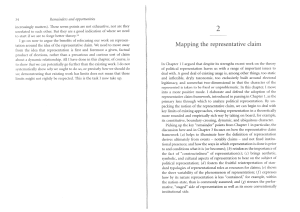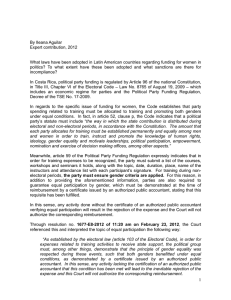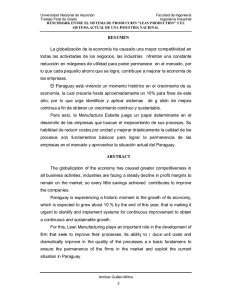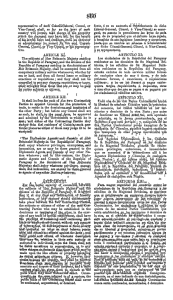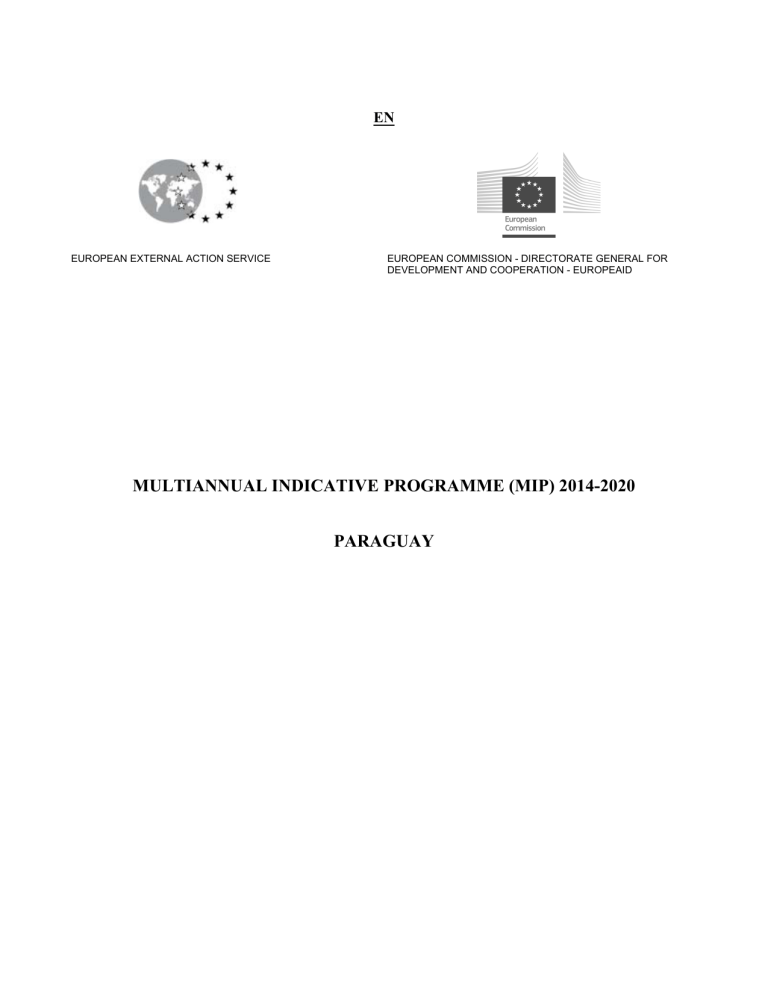
EN EUROPEAN EXTERNAL ACTION SERVICE EUROPEAN COMMISSION - DIRECTORATE GENERAL FOR DEVELOPMENT AND COOPERATION - EUROPEAID MULTIANNUAL INDICATIVE PROGRAMME (MIP) 2014-2020 PARAGUAY MULTIANNUAL INDICATIVE PROGRAMME FOR PARAGUAY 2014-2020 1. THE OVERALL LINES FOR THE EU RESPONSE 1.1. STRATEGIC OBJECTIVES OF THE EU'S RELATIONSHIP WITH THE PARTNER COUNTRY The strategic objectives of the EU in the relations with Paraguay are to contribute to its social, economic and institutional development, to promote regional integration on the South American continent and to develop partnerships with the country for bilateral and global issues of common interest. These objectives can be reached by strengthening political relations and economic financial and technical cooperation, coordination in international fora, as well as by expanding information activities aiming at improving local knowledge of the EU and its values. EU financial and technical cooperation instruments will particularly be used for: • Human capital development, improving productivity of the labour force and reducing inequality and poverty. The focus will be on improving access to, and quality of, education; • Improving the business climate, conducive to trade and investments, strengthening of the policy-making and implementation capacities of institutions in this field, improving the participation of private-sector entities in policy design, and reducing the administrative burden for businesses; • A stable and socially inclusive Paraguay. The support in this field will concentrate on the design and implementation of policies that promote a more equal wealth distribution, increase social cohesion and reduce poverty; • Strengthening of democratic institutions in Paraguay, among others by implementing the recommendations of the 2013 EU’s Election Observation Mission. Instead of addressing it as a cross-cutting issue, democratisation, participation and institutional strengthening was made a fourth focal sector in order to increase its visibility and impact. In the area of development cooperation, the EU and its Member States1 have agreed to start a joint programming process, including a joint analysis and response to coordinate their programming exercises, covering the period 2014-2020. The multiannual indicative programme (MIP) has been drawn up taking into account the key development policy documents of the EU, most notably the Agenda for Change and the Strategic Framework and Action Plan on Human Rights and Democracy. The EU promotes a rights-based approach to development in pursuit of the objectives set out in this document. 1.2. 1 CHOICE OF SECTORS Including France, Germany, Italy, Spain and the United Kingdom. 1 Over the last decade, Paraguay has enjoyed a period of fairly robust economic growth, averaging 4.5 % annually, although with strong fluctuations, resulting from its high dependence upon agricultural commodity2. Notwithstanding Paraguay's growth performance, improvements in the Human Development Index have been moderate, and extreme poverty, which had remained roughly constant over the last decade, decreased from 18 % registered in 2011 to 10 % in 2013. Inequality in income distribution has remained high over the period, indicating that the poorest segments of the population have less than proportionally benefited from growth. President Cartes has made the fight against poverty one of the dominant themes of his electoral campaign and his Government Programme. A National Development Plan (NDP) covering the period 2014-2018, subject to final approval of the Paraguayan government, is currently being finalised. The main priorities of the NDP are as follows: 1) Poverty reduction and social development, 2) Inclusive and sustainable growth and 3) Integration of Paraguay in world markets. The first priority of the NDP encompasses the current extreme poverty reduction programme Sembrando Oportunidades3. A central cross-cutting theme will be institutional strengthening, transparency and fight against corruption. Based on the priorities established in the EU Agenda for Change, the analysis of development needs in Paraguay, national priorities and the division of labour agreed in the context of joint programming, the Government and the EU decided to focus cooperation on the following priority sectors: 1. Education; 2. Private sector development; 3. Social protection; 4. Democracy, participation and institutional strengthening. The EU consulted representatives of civil society and the private sector on the choice of priority sectors in August 2013. Besides being an important interlocutor throughout formulation and implementation, civil society also plays a key role in holding authorities accountable with regards to reform progress. The EU has been supporting and will continue to support Paraguay's efforts to step up the level of dialogue with civil society and the private sector. The EU will also seek to strengthen civil society organisations' capacities through its thematic programmes and ensure complementarity with other EU cooperation instruments such as continental programmes for Latin America. The EU response may be complemented by operations financed by the European Investment Bank. 1. Education The country began an extensive modernisation of its educational system in the early nineties furthered by the National Education Plan 2024, in force since 2009. This plan aims “to guarantee the access to, the improvement of quality, efficiency and equity of the Paraguayan education as a public good and provide an education that corresponds to changing world requirements and challenges, with a view to 2 This is a structural cause of fragility of the Paraguayan economy. Its agricultural sector represents 25% of GDP and 70% of total exports and is subject to weather conditions, international price volatility, as well as SPS-related issues such as outbreaks of foot and mouth disease. 3 "Sowing Opportunities". 2 close the education gap”. The Plan 2024 develops three main areas of work: equality of opportunities in access to education; quality of education; and effective and participative management of education policies at all territorial levels. An education of quality is considered a universal right in Paraguay and represents a key element of the poverty reduction chapter of the draft National Development Plan. Significant progress has been registered in the education sector in Paraguay, since the adoption of the Plan 2024, to which the EU has been contributing since 2009. For instance, near universal access to and gender parity in the first 6 years of primary school has been achieved4, while the coverage of schools provided with supply kits widened. Quality of education has also improved thanks to teacher training programmes, including for multilingual teachers (i.e. for indigenous communities), and increased use of open competitions for teacher recruitment. In addition, the EU has supported improvements in education governance, among others by advocating and facilitating the introduction of programme-based budgeting. Despite these improvements, significant challenges remain: - Only 50% of students complete the 9 compulsory years of primary schooling and 35 % the full 12-year curricula. Important differences also remain between urban and rural areas. - Repetition and dropout rates remain substantial, despite improvements in recent years. International comparisons show that student performance in Paraguay is significantly below regional standards (e.g. 50 % of students are at the lowest levels in math). This calls, among others, for further progress in teacher training and curriculum review. - G overnance in education needs to be further improved, especially in a context of increasing decentralisation of public spending. Improving quality, access and completion of education is paramount to develop human capital, foster social cohesion and enhance productivity. Despite progress made, the performance of the sector remains weak compared to both regional and international standards as the data above shows. The low quality of education is frequently mentioned as one of the main stumbling blocks to development in Paraguay.5 In addition, environmental degradation and climate change are known to have negative effects on dropout rates and poverty levels, especially in rural areas.6 Children from low-income areas, both slum and rural areas, cannot attend school due to flooding and other climate change related phenomena. The education system can help increase the level of environmental awareness and reduce vulnerability to climate change by strengthening its adaptive capacity, including disaster preparedness and management. The EU will, in line with the Plan 2024, contribute to guarantee the access, to improve quality, efficiency, equity and governance of Paraguayan education for all children and youth. The EU will also seek to raise environmental and climate change issues in the sector policy dialogue. 4 MDG 2: “achieve universal primary education”, and MDG 3: “eliminate gender disparity in primary and secondary education”. It should be noted that in Paraguay primary school lasts 9 years and is composed of three cycles of three years each. 5 Education is widely recognised as a limiting factor to Paraguay's development. See, among others, the Global Competitiveness Report on Paraguay, http://reports.weforum.org/global-competitiveness-report-2012-2013/ 6 PNUD (2007) “Cambio climático: Riesgos, vulnerabilidad y desafío de adaptación en el Paraguay”. 3 Given the good results achieved, the strength of the policy framework reached in the Strategic Agenda for Education 2014-2018, as well as the level of policy dialogue, the EU proposes to continue supporting the implementation of the national education reform programme, "Plan 2024". Finally, it is also worth highlighting that, following a comprehensive exercise of division of labour at the EU level, Spain has withdrawn its support from education and the EU has become the main donor in this field. 2. Private sector development and trade policy The G overnment has embarked on a significant reform of the economy. A law on public-private partnerships and one imposing budgetary discipline were approved in 2013. An investment protection framework and a new industrial policy are being drafted. Private sector development and trade policy are indeed key areas of focus of the Government of Paraguay and two of the three main axis of its draft National Development Plan relate to private sector development and trade. The Plan emphasises the role of SMEs as one of the pillars of the route out of poverty due to their potential in job-creation. In spite of fairly robust growth over the past years, extreme poverty has remained constant, implying that large portions of the population have not benefitted significantly from economic growth. Economic development has been driven by agricultural commodity exports, with the contribution of the manufacturing sector remaining limited, and services being on the rise. The key challenge in this area is to generate inclusive and sustainable growth by diversifying the economy and ensuring broader participation in productive employment. Major international benchmark surveys, like the Doing Business or the World Competitiveness Report, rank Paraguay below regional averages with regards to its competiveness and investment climate and point towards high levels of informality and underemployment, low skill levels (linked to weak education performance and gaps between labour demand and supply), high bureaucratic burden, limited access to credit, and significant lack of infrastructure. Yet the country benefits from macroeconomic stability, abundant cheap energy, limited fiscal pressure, young workforce and low labour costs. Over the past years, the EU has supported Paraguay in its efforts to improve competitiveness. It successfully contributed to the reduction of the administrative burden for export through the development of a single register for exporters, accompanied efforts to increase the value-added of production through strengthening of value chains, technical norms, capacity-building in selected sectors, dissemination of production best practices, and fostered the creation of public-private dialogue in various sectors. Project evaluations have shown that actions should concentrate on a limited number of areas of activity and that a better link to relevant sector policies should be pursued. As a consequence, EU’s support will focus on the strengthening and implementation of the institutional, policy and regulatory framework for sustainable and inclusive growth. Actions will aim to improve the business environment and competitiveness, focusing on enhancing technical capacity, the capacity to integrate into the world markets, dissemination of sustainable production practices and green business opportunities. The programme will promote resource- and energy-efficient practices, environmental management, sustainable production, eco-efficiency, provision of green market intelligence and awareness of new green business opportunities. Support actions will also seek to reinforce potential benefits stemming from the EU-Mercosur trade negotiations and GSP+. In addition, the EU’s continental programmes will provide complementary support through, for example, vocational training, linking business organisations across the continent or its blending facility 4 (LAIF), that could accompany Paraguay's efforts to close its important infrastructure deficit or to ease access to finance. As regards division of labour, the key donors are IADB and the WB, with presence of G IZ, AECID though with more limited budget. Sector dialogue is limited and lacks a key lead donor. The EU will seek to strengthen synergies with other donors. 3. Social Protection The first Social Development Policy of Paraguay, Paraguay para Todos y Todas, was adopted in 2009 setting out a vision for 2020. Its strategic axes include 1) quality of life for all with objectives in terms of health, education, habitat, water, sanitation, identification and food security; 2) social inclusion and fight against poverty and inequality with focus on infancy, and indigenous land; and 3) economic growth without exclusion covering employment and agrarian reform. Social development and protection constitute important themes for the Paraguayan authorities. Building upon previous work in the area, the government is further defining specific priorities for social protection within the upcoming National Development Plan. The draft chapter "Poverty reduction and social development" mentions the importance of integral social protection from early childhood (covering health, nutrition, education), youth in situations of vulnerability, the much needed development of social protection policies as well as attention to the elderly. Implementation of the social protection policy is ensured by the Social Cabinet which responds directly to the President and is in charge of coordinating the different line Ministries involved. Progress has been registered in a number of key social indicators, such as illiteracy rate which dropped from 20 % in the 1980s to 5 % in 2010; net primary school enrolment which increased to close to 100 % for the 6 first years; child mortality rate, which dropped from 40 in 1990 to 18.7/1000 in 2009 and maternal mortality rate which decreased from 164 in 2000 to 100.8/100.000 live babies in 2010. A conditional cash transfer programme aimed at improving health and education of families in situation of vulnerability and extreme poverty has recorded positive results, among others in vaccination rate. Yet 32 % of the population is living below the poverty line, and 10 % in extreme poverty. Environmental degradation (primarily land degradation, deforestation and water pollution) contributes to perpetuate the levels of poverty. Climate change, through increased recurrence of drought and more intense rainfall events, exacerbates the trend as it decreases agricultural productivity and generates job loss and increased food insecurity. The EU has been active in this area since 2006. It contributed to the definition of Paraguay's first comprehensive social protection policy (as part of the 2009 Social Development Policy), and to the establishment and strengthening of the Social Cabinet as a lead entity in charge of sector coordination. Furthermore, the EU has helped putting in place a multi-year and result-oriented sector budgeting system. G iven the prevalence of poverty in the country and the persistent inequalities, the key challenge is to widen the coverage of the social protection system and to improve the quality of the service. Given the preeminent role that the EU has played in this field and the scope of the challenge in this sector, the EU will continue supporting Paraguay's social development objectives. As regards division of labour, other donors active in this area are AECID, World Bank, Inter-American Development Bank and UNDP. 5 4. Democracy, Participation and Institutional strengthening After the controversial impeachment of President Lugo in June 2012, Paraguay invited the EU to deploy an Election Observation Mission (EOM) for the General Elections of April 2013. The EOM produced a number of recommendations, in the following areas: • compliance with international commitments in the field of political rights; • procedures and regulations for the full application of the law; • enhanced independence of the electoral justice and its opening to participation of all political parties; and • reinforcement of the separation of powers in the State to warrant due balance and independence. Several recommendations are expected to be addressed once the ongoing reform of the Electoral Code and the Electoral Justice Law will be completed. The EU will accompany its implementation, among others through training and actions to increase citizens' awareness on the electoral process, and reinforce a culture of accountability. Stakeholders and participants for the training and information programme could include: judges, law enforcement officers, journalist, local authorities and local leaders, members of parliament, electoral commission officers, candidates and citizens in general, in particular in rural areas and indigenous communities. Currently, there is no other donor active in this area. The Organisation of American States (OAS) provided support during the election period, and provides targeted technical assistance to the TSJE on demand. However, in the wider area of "governance", several donors are active, such as: access to justice (BID), transparency (USAID, BID); local governance (G iZ); public administration reform (AECID, PNUD, USAID); good governance and social accountability (WB). The EU will exploit synergies with its complementary thematic programmes, notably the European Instrument for Democracy and Human Rights, which provides support to civil society organisations in the area of electoral monitoring, accountability, transparency and awareness rising. Inter alia accountability and transparency can be ensured through a systematic implementation of the Human Rights Based Approach. Implementation modalities remain to be determined but could include, among others, direct management through project approach and/or budget support, if conditions allow; indirect management with Member States agencies, International Organisations or Latin American countries. 2. FINANCIAL OVERVIEW The indicative amount is EUR 168 million Amount (m EUR) % of total Education 85 51% Private sector development 20 12% Social Protection 48 28% Sector 6 Democracy, Participation and Institutional Strengthening 10 6% Support measures 5 3% 168 100% TOTAL 3. EU SUPPORT PER SECTOR 3.1. Education (indicative amount EUR 85 million) 3.1.1 The following overall and specific objectives will be pursued: Overall objective: Contribute to guarantee the access, the improvement of quality, the efficiency and equity of Paraguayan education as a public good for all children and youth, regardless of individual circumstances Specific objective 1: Improve access to primary and secondary education Expected Result 1: Increased access to primary and secondary education Main indicators The main indicators for measuring the aforementioned results are contained in the sector intervention framework attached in Annex 3. Specific Objective 2: Reduce inequalities in access to and completion of education Expected Result 2: Improved access and completion rates for both boys, girls and youth from the rural population Specific Objective 3: Improve the quality of education and strengthen the education system Expected Result 3: Improved quality of primary and secondary education Expected Result 4: Improved awareness of environment and climate change amongst school children The main indicators for measuring the aforementioned results are contained in the sector intervention framework attached in Annex 3. 3.1.2. Donor coordination and policy dialogue The EU is the largest donor in education, with a considerable in-house experience and ample recognition by national authorities as a key partner in this field. Policy dialogue is developed under the current budget support implementation. The round table on Education is currently coordinated and led by the Ministry of Education with the participation of several donors. 7 3.1.3. The Governments financial and policy commitments The 2024 National Education Plan is the basis for the annual budget process. The 1992 Constitution declares that the budget allocated to education should not be inferior to 20 % of the total budget assigned to central administration (excluding loans and grants). Budget allocations to education declined in 2012 and 2013, but are expected to increase again slightly in 2014. Although budget allocation to education reaches levels close to the 20 % threshold, the country's 3.8% of GDP assigned to education remains well below the 6 % recommended by UNESCO, among the region's lowest level of public spending per student. The Ministry of Finance will decide the budgetary allocation according to the prioritisation of programmes proposed by the Technical Planning Secretariat (STP). 3.1.4. Environmental assessment Without being the subject or the main cause of high environmental risks, education plays a key role in raising awareness of future generations as regards the importance of preserving the environment and the risks deriving from climate change and climate-related events. Environmental themes are included in school curricula and will be covered in the policy dialogue. 3.1.5. The overall risk assessment of the sector intervention The main conditions for EU’s support are policy continuity, macroeconomic stability and progress in Public Finance Management (PFM) reform and transparency in managing public funds. The Minister of Education and Culture has confirmed continuation of the existing policy framework (2024 National Education Plan). The EU will continue supporting PFM, and no major risks are to be expected in the medium term. However, limited budgetary resources and weak coordination with the FONACIDE trust fund (which manages substantial investment resources in education at national, departmental and local level) remain risks to be monitored during the implementation of the EU’s support. Environmental degradation, as well as the increased risks associated to natural hazards under climate change (e.g. increased drought and rainfall intensity) can lead to an increase in school drop-out rates in the rural area, compromising some of the objectives under this support programme. 3.2. Private Sector Development and Trade Policy (indicative amount EUR 20 million) 3.2.1 The following overall and specific objectives will be pursued: Overall objective: Contribute to sustainable and inclusive growth through an improved investment climate and enhanced competitiveness Specific objective 1: Improved investment climate Expected Result 1: Enhanced institutional capacity of national authorities, think tanks, research institutes, and other organisations to formulate and implement trade and private sector policies and to identify paths for the transformation towards a green economy. Expected Result 2: Improved legal, regulatory and administrative framework for doing business and fostering socially and environmentally responsible investment and business opportunities Specific objective 2: Enhanced firm-level competitiveness 8 Expected Result 3: Capacity of business intermediary organisations and business development service providers improved, including those related to trade and investment promotion, CSR and "green(er) business". Expected Result 4: Quality and diversity of Paraguayan goods and services improved in selected sectors with decent job and environmentally sustainable growth potential. The main indicators for measuring the aforementioned results are contained in the sector intervention framework attached in Annex 3. 3.2.2 Donor coordination and policy dialogue Except for the area of "rural development", of which some elements are linked to trade and private sector development, there is currently no formally structured policy dialogue or donor coordination mechanism in this area. The EU will push for better coordination and dialogue with national authorities. Synergies with Member States and other donors in the area will be exploited during all the project management cycle. 3.2.3. The Government's financial and policy commitments The objectives of sustainable and inclusive growth are included in the draft National Development Plan. The government allocated substantial resources for the development of the private sector: the national budget for 2014 provides for EUR 162.7 million for the two institutions working in this field, i.e. the Ministry of Industry and Trade and the Ministry of Agriculture and Livestock. In addition, the present authorities are in the process of designing an industrial policy, to which the EU is already contributing7, and a policy on investment protection. The EU aims to accompany the development and implementation of such policies through the proposed activities. Where possible, the EU will support incorporation of green growth objectives. 3.2.4. Environmental assessment There is still a low level of environmental awareness and interest in Paraguay despite the dependence and vulnerability of the economy to climate change and related recurrent emergencies. Institutional positioning and national capacities are particularly weak in this area. Nevertheless, the country has a high potential for green growth, given its rich natural endowments and biodiversity, and huge clean energy availability, making it extremely relevant to stimulate reflections in this area. Focusing on green economic opportunities is a key catalyst to raise environmental awareness, political interest, and contribute to building resilience in the most vulnerable areas. The EU will apply Environmental and Climate Risk Screening8 during programme/project identification to assess the need for a Strategic Environmental Assessment and/or a Climate Risk Assessment. 7 8 Notably in the framework of the "Economic integration project" with the Ministry of Industry and Trade. "Guidance for the Integration of Environment and Climate Change in EU Development Cooperation". 9 3.2.5. The overall risk assessment of the sector intervention Enhanced trade and competitiveness through private sector development is a priority area for the Cartes government and can be considered a low-risk sector. The EU has a long history of positive intervention in this area. Macroeconomic stability and progress in public finance management will be duly evaluated, should implementation through a sector reform contract be considered. Natural disasters associated with climate change and environmental degradation can compromise some of the development achievements through high volatility of G DP and reduced business competitiveness. The EU will give special attention to the development of a climate-resilient and environmentally sustainable business sector. 3.3. Social protection (indicative amount EUR 48 million) 3.3.1. The following overall and specific objectives will be pursued: Overall Objective: Contribute to extreme poverty reduction by strengthening the social protection system, enhancing the quality of and access to public services Specific objective 1: Improve the effectiveness, efficiency, financial sustainability, tr anspar ency, accountability of the social protection system Expected Result 1: Enhanced capacity of the public administration in charge of social protection and other relevant stakeholders to develop, implement, finance, coordinate, monitor and evaluate the social protection system Specific objective 2: Widen cover age and impr ove access of the poor and vulner able to social benefits and basic social services Expected Result 2: Improved coverage of the social protection system The main indicators for measuring the aforementioned results are contained in the sector intervention framework attached in Annex 3. 3.3.2. Donor coordination and policy dialogue Policy dialogue with the relevant Paraguayan authorities is on-going in the context of the current sector reform support. Donor coordination needs further improvement and the EU will seek a more prominent role, notably in the framework of the National Development Plan. 3.3.3. The Government's financial and policy commitments The national policy for social protection will be defined in the National Development Plan and will build on the Social Development Policy adopted in 2009. The Social Cabinet, part of the Technical Planning Secretariat (STP) will continue to be in charge of its definition and implementation. The Ministry of Finance will decide the budgetary allocation according to the prioritisation of programmes 10 proposed by the STP. The share of the budget allocated to social protection increased from an average of 9.4 % during 2008-2012 to 11.6 % in 2013 and is projected to further edge up to 14 % in 2014. 3.3.4. Environmental assessment The majority of the poor lives in rural parts of the country which are the most vulnerable to climate change. The country experiences regular inundations and droughts. Strengthening resilience9 of the most affected populations as well as ensuring appropriate risk management mechanisms are key to ensuring social protection for all. 3.3.5. The overall risk assessment of the sector intervention Poverty reduction is one of the highest priorities of the Cartes G overnment. The government is presently defining the National Development Plan, focusing on poverty reduction and protection of the most vulnerable. This plan, together with the 2009 Social Development Policy, will be the basis for future activities. The solidity and clarity of the National Development Plan, in terms of objectives, indicators, financing and implementation mechanisms will be key for the implementation of future cooperation activities. Additional risks are related to environmental degradation affecting public health, especially through air pollution in urban centres, water pollution and food insecurity (linked to land degradation). Climate change will also increase the risks associated to natural hazards (e.g. dynamics of disease vectors, extreme weather events). Appropriate mitigation mechanisms will be discussed during programme design. 3.4. Democracy, Participation and Institutional Strengthening (indicative amount EUR 10 million) 3.4.1. The following overall and specific objectives will be pursued: Overall objective: Support democracy, credible elections in line with the national legislation and international conventions subscribed by the country, rule of law and the functioning of public institutions. Specific Objective 1: Ensur ing a consistent and coher ent elector al legal, r egulator y and administrative framework. Expected Result 1: A credible electoral cycle and improved democratic performance 9 Resilience building is an overarching goal as outlined in the European Commission's Communication on Resilience (COM(2012)586 final and SWD(2013)227 final), In this context, the EU has consistently supported prevention and preparedness for disasters in the most vulnerable countries and identified the need to integrate disaster risk reduction and adaptation to climate change, notably into both development cooperation and humanitarian response. 11 Specific objective 2: Strengthening the institutional and administr ative capacity of the institutions in charge of electoral administration and electoral justice Expected Result 2: Enhanced transparency and accountability of electoral administration and electoral justice The main indicators for measuring the aforementioned results are contained in the sector intervention framework attached in Annex 3. 3.4.2. Donor coordination and policy dialogue EU’s support actions in this area will be regularly discussed in the donor round-table on governance. However, topics discussed in this round-table are rather broad10, leading to multiple public sector counterparts. Hence, the round-table is essentially a platform for donor-coordination, rather than a space for public dialogue. Nevertheless, in the area of electoral reform, the EU keeps a regular policy dialogue with the Supreme Electoral Court (TSJE) and with relevant civil society organisations. 3.4.3. The Governments financial and policy commitments The government has welcomed the recommendations of the EUEOM and is already in the process of addressing several of the concerns raised. The Supreme Electoral Court is drafting a reform of the Electoral Law and the Law which regulates the Electoral Justice, which will address a significant number of recommendations. Furthermore, in view of 2015 municipal elections, the TSJE has started the updating of the electoral register. The resources that have been allocated to the TSJE under the 2014 national budget amount to EUR 92.8 million. 3.4.4. Environmental assessment Not applicable 3.4.5. The overall risk assessment of the sector intervention The final report of the EUEOM includes a number of recommendations that have a technical nature (e.g. updating of the electoral register) and others that require more complex political decisions (independence of the judiciary, opening up electoral justice to more political parties). While the former could be already implemented in the short to medium term, the latter might need an integrated longerterm approach. The political dialogue with local authorities will be the main tool for addressing possible risks arising in the implementation of the EUEOM’s recommendations. 10 Including access to justice (BID), transparency (USAID, BID), local governance (GiZ), public administration reform (AECID, UNDP, USAID) and good governance and social accountability (WB). 12 4. SUPPORT MEASURES (EUR 5 million) The main aim of such measures is capacity building and providing technical assistance in a more efficient and structured manner. These resources are envisaged to support communication and visibility activities to raise awareness of EU aid. They can also be directed to thematic studies and impact assessments of projects, support to formulation of public policies and policy dialogue, and short-term technical assistance, as well as to support aid efficiency initiatives such as donor coordination and division of labour. 13 Attachments 1. Country at a glance 2. Donor matrix showing the indicative allocations per sector 3. Sector intervention framework and performance indicators 4. Indicative timetable for commitment of funds 14 Attachment 1. Country at a glance Country at a glance: EU position in the country: Population: 6.7 million (2012) EU Rank (volume of grant aid in the country20): number 1 Country Classification : Lower Middle Income Country (World Bank) Human development index11: 0.669 (in 2013). Rank 111 Life expectancy: 72 years Poverty rate: 32.4 % of population (2011) GDP per Capita 201212: 3290 US$ (2012). Rank : 140 over 214 countries Number of donors in the country: 10 main donors: EU, DE, ES, JP, KR, FOCEM, TW, WB, IADB, USAid, EU allocation for MIP: EUR 130 million (2007-2013) EUR 168 million (2014-2020) EU% of ODA in the country17: 15.9 % Worldwide Governance Indicators13 (2012) expressed at the rank of among all countries in the world (0 being the lowest rank and 100 the highest) : Voice and Accountability: 44.1 Political Stability/Absence of Violence: 20.4 Government effectiveness: 19.6 Regulatory Quality: 41.2 Rule of Law: 20.9 Control of Corruption: 22.5 Red Flags for Food Security14: N Fragility according to OECD list of fragile states15: N Member of the G7+ initiative for fragility16: N New Deal pilot country or assimilate: N 11 http://hdr.undp.org/en/data/profiles/ http://data.worldbank.org/data-catalog/world-development-indicators 13 http://info.worldbank.org/governance/wgi/index.aspx#reports 14 Note DOS-FF, "Sustainable agriculture and food security in development cooperation for 2014-2020, ARES(814817)". 15 http://stats.oecd.org/qwids/ 16 http://www.g7plus.org/ 17 Source: Technical Planning Secretariat (STP). 12 15 Attachment 2. Donor matrix Matriz de Donantes (Millones de dólares) Ejes/Sectores Eje 1 Social-Humano Agua y Saneamiento Educación Reducción a la Pobreza Salud Vivienda Niñez y Adolescencia Indígena Género Seguridad Alimentaria Seguridad Ciudadana Otros Cultura Migración Derechos Humanos Eje 2 Económico-Productivo Energía Programas Viales Agropecuario y Desarrollo Rural Ambiente MPyMES Empleo Transporte Competitividad Turismo Microfinanzas Eje 3 Político-Institucional Fortalecimiento Institucional Democracia y Gobernanza Descentralización TIC's TOTAL Fuente: STP, 2012 Sectores FOCE M España 50,2 19,2 Taiwan UE 71,0 111,3 38,8 5,9 Japón 32,8 0,1 USA 3,4 0,3 1,0 1,2 ONU 1,0 BID 2,2 1,8 2,8 0,4 3,7 0,1 0,9 2,0 0,0 0,3 1,0 0,4 0,3 Alemania Corea BIRF 5,0 OEAM arruecos IICA CAF 0,1 4,8 0,7 2,0 0,2 0,7 9,8 0,0 0,0 400,0 96,0 5,0 3,7 8,0 M OI 0,0475 0,1 0,2 1,5 2,7 0,4 0,3 8,9 1,8 4,3 0,7 1,1 0,2 2,6 2,0 0,2 12,5 0,020 1,9 0,8 5,9 0,8 8,7 7,1 24,6 0,6 0,2 26,8 0,3 0,6 34,7 3,4 7,1 503,1 94,9 0,4 72,1 162,5 54,2 36,5 (Focem: Mercosur’s structural convergence fund) 16 1,7 0,2 14,7 23,6 0,0045 0,029 13,8 1,1 1,8 0,7 0,6 0,2 0,1 Attachment 3. Sector intervention framework Sector 1: Education Specific objective 1: Improve access to primary and secondary education. Expected Results 1. Increased access to primary and secondary education Indicators Baseline (2012) Net Enrolment Rate for 3rd cycle of primary and secondary education disaggregated by gender M eans of verification 3rd cycle: Total: 58.8 % Male: 56.2 % Female: 61.5 % Statistical Information System, Ministry of Education Secondary: Total: 45.9 % Male: 42.8 % Female: 49.2 % Specific objective 2: Reduce inequalities in access to and completion of education for girls and boys, and children/youth from rural population. Expected Results 2. Improved access and completion rates for both boys and girls from the rural population Indicators Baseline (2012) M eans of verification Statistical Information System, Ministry of Education Net enrolment rate of rural population compared to urban population for 3rd cycle primary education and secondary education 3rd cycle: Urban: 72.6 % Rural: 41.4 % Gender parity index of completion 3rd cycle primary education and secondary education 3rd cycle: Male completion: 45.5 % Female completion: 54.4 % Parity: 1.2 Secondary: Urban: 63.2 % Rural: 24.1 % Secondary: Male completion: 31.1 % Female completion: 38.7 % Parity: 1.2 Dropout rates, 3rd cycle primary education and secondary education Dropout rate 3rd cycle: 4.9 % Dropout rate secondary: 4.6 % Specific objective 3: Improve the quality of education and strengthen and further develop education systems Expected Results 3. Improved quality of primary and secondary education Indicators Baseline (2012) M eans of verification Number of teachers and/or school managers trained 10.000 teachers and school managers trained Ratio of public spending on education to total public 12.9 % Statistical Information System, Ministry of Education Ministry of Finance 17 spending 4. Improved awareness of environment and climate change among school children Climate change integrated in the primary and secondary school curricula Baselines will be included in the Action documents at the latest. Ministry of Education Sector 2: Private Sector Development and Trade Policy18 Specific objective 1: Improved investment climate Expected Results Indicators Baseline (2012) 1. Enhanced institutional capacity of national authorities, think tanks, research institutes, and other civil society organisations for trade and private sector policy formulation and implementation, taking into account possibilities for the transformation towards a green economy Sector policy formulated with effective participation of all stakeholders, referring to social and environmental impact as well as opportunities for climate change mitigation and adaptation Absence of sector policy Formal adoption by concerned ministry, BCP, DGEEC 2. Improved legal, regulatory and administrative framework for doing business and fostering socially and environmentally responsible investment Selected Doing Business and World Economic Forum indicators Doing Business Distance to Frontier 2014: 61.10 Doing Business report, World Bank Investment Climate Assessment Volume of investment flows M eans of verification Baselines for specific indicators will be included in the Action documents at the latest Central Bank of Paraguay 4.5 bn US$ Specific objective 2: Enhanced firm-level competitiveness Expected Results 3. Capacity of business intermediary organisations Indicators Baseline Number of business development services offered in Baselines will be included in the Action documents at the 18 M eans of verification BDS market survey ex The main indicators to be monitored are detailed in the table. More specific indicators, base lines and targets will be defined in individual projects and programmes, once the sector policy has been adopted. This will include indicators related to environment and climate change (e.g. number and type of "green" and "socially responsible" business development services offered, share of environmentally or socially labelled goods and services, mainstreaming of environment and social impact into policy development), climate change (e.g. energy efficiency, low-carbon and climate resilience), labour standards and gender mainstreaming. 18 and business development service providers improved (including those related to CSR and green business) targeted activities,19 latest ante and ex post 4. Quality and diversity of Paraguayan goods and services improved, in selected sectors with decent job and environmentally sustainable growth potential Net additional job creation (disaggregated by gender) in targeted sectors Baselines will be included in the Action documents at the latest WEF Report IFC Enterprise survey BCP Production volume, quality (as measured by labels, controls, etc.) and diversity of destination markets reached by the selected sectors ILO Project level measurement Sector 3: Social Protection Specific objective 1: Improve the effectiveness, efficiency, financial sustainability, transparency and accountability of the social protection system. Expected Results Indicators Baseline 2013 1. Enhanced capacity of the public administration in charge of social protection and other relevant stakeholders to develop, implement, finance, coordinate, monitor and evaluate the social protection system Existence of single register of beneficiaries of social programs M eans of verification Social fiche designed ad being implemented Registers of Social Cabinet Specific objective 2: Widen coverage and improve access of the poor and vulnerable to social benefits and basic social services. Expected Results Indicators Baseline 201320 2. Improved coverage of the social protection system Percentage of the population having access to predictable 19.15 % 19 M eans of verification Records of the Secretary for Social Including number of "green" and "socially responsible" business development services offered (e.g. energy and resource efficiency, environmental management systems, energetic audits, green market intelligence, etc.) 20 Unless otherwise stated. 19 cash benefits, in particular for the two lowest quintiles (2011) Percentage of older people receiving pensions Percentage of population having access to health services, in particular of the two lowest quintiles. Action 23.31 % Registers of Social Cabinet 69.7 % Sector 4: Democracy, Participation and Institutional Strengthening Specific objective 1: Ensuring a consistent and coherent electoral legal, regulatory and administrative framework. Expected Results 1. A credible electoral cycle and improved democratic performance Indicators Baseline (2013) M eans of verification Electoral Code reformed, including key EUEOM recommendations; and implementing regulations approved. Consistency and coherence of the reformed electoral code with the general legal and regulatory framework Coverage of National voter registration system, in particular of men, women, young people and Paraguayans living abroad Participation rates of various groups in elections with respect to the number registered Knowledge of electoral rights among citizens, in particular indigenous populations, the disabled and women, as measured by their explicit inclusion in the communication plan of the TSJE, and targeted awareness 20 Official Journal Electoral law and electoral code reform include the modifications of the articles targeted by the EUEOM recommendations Baselines will be included in the Action documents at the latest Baselines will be included in the Action documents at the latest Official Journal Voter registry Citizen awareness campaigns Communication plan of campaigns the TSJE Specific objective 2: Strengthening the institutional and administrative capacity of the institutions in charge of electoral administration and electoral justice Expected Results 2. Enhanced transparency and accountability of electoral administration and electoral justice Indicators Baseline (2013) Existence of a system for the appointment of judicial posts based on competences Existence of reports on election funding publicly available M eans of verification Absence of a system for the appointment of judicial posts based on competences List of judicial posts appointed by competences Public websites Absence of publicly available reports on election funding The results, indicators and means of verification specified in the present annex may need to evolve to take into account changes intervening during the programming period. 21 Attachment 4. Indicative timetable for commitments Indicative allocation 2014 SECTOR 1 – Education 85 m EUR 44 SECTOR 2 –Private Sector Development and Trade Policy 20 m EUR 7 SECTOR 3 – Social Protection 48 m EUR 48 SECTOR 4 – Democracy, Participation and Institutional Strengthening 10 m EUR 10 Support measures 5 m EUR 5 168 m EUR 49 Total Commitments 2015 2016 2017 2018 2019 41 65 6 7 6 48 In line with the Joint Programming process and in order to ensure synchronisation with the national cycle, a mid-term review of the MIP will take place in 2018 22 2020
